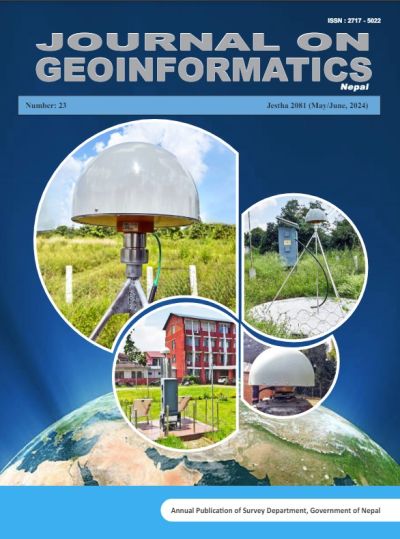Assessing the Impact of Urban Expansion on Forest Cover using LULC Maps, NDVI, and NDBI: A Case Study of Kathmandu District
DOI:
https://doi.org/10.3126/njg.v23i1.66045Keywords:
NDVI, NDBI, Deforestation, Urbanization, LULCAbstract
Rapid urbanization poses significant challenges to the delicate balance between urban development and environmental conservation. This study investigates the impact of urban expansion on forest cover in the Kathmandu District, employing a comprehensive approach that integrates Land Use/Land Cover (LULC) maps, Normalized Difference Vegetation Index (NDVI), and Normalized Difference Built-Up Index (NDBI). The aim of the study area is to provide insights into the dynamic interplay between urban growth and its consequences on the region's ecological landscape. LULC maps derived from remote sensing data offer a spatially explicit representation of land-use changes over time, enabling the identification of areas where urbanization has encroached upon forest area. The NDVI, a vegetation health indicator, serves as a quantitative measure of changes in the density and health of vegetation cover, aiding in the assessment of ecological impacts. Complementing this, the NDBI highlights intensity of built-up areas, allowing for a nuanced understanding of the urbanization process. This study employs NDBI and NDVI to dynamically assess urban growth and land use cover change, enhancing analytical accuracy. Findings reveal a substantial 89.9 km² increase in built- up areas between 2013 and 2016, coupled with a minor 18.4 km² increase between 2016 and 2021, reflecting continuous urban expansion driven by population growth and development initiatives. Concurrently, forest area marginally increased by 2.3 km² in 2016, suggesting reforestation and conservation efforts, yet a subsequent 23.5 km² decline by 2021, due to deforestation, urban encroachment, and natural disasters such as wildfires. Notably, vacant land decreased by 92.3 km² in 2016, absorbed by built- up areas and forest expansion, underscoring the urgent need for spatial planning to accommodate the growing population and its evolving needs.




